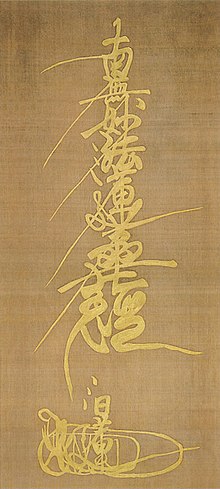
Namu Myōhō Renge Kyō (南無妙法蓮華經; sometimes truncated phonetically as Nam Myōhō Renge Kyō)[1] (English: Devotion to the Mystic Law of the Lotus Sutra / Glory to the Dharma of the Lotus Sutra)[2][3] are words chanted within all forms of Nichiren Buddhism.
An inscription of Nam Myoho Renge Kyo by renowned Japanese artisan Hasegawa Tohaku. Toyama, Japan. Circa Momoyama period, 1568.
The words Myōhō Renge Kyō refers to the Japanese title of the Lotus Sūtra. The mantra is referred to as Daimoku (題目)[3] or, in honorific form, O-daimoku (お題目) meaning title and was first publicly declared by the Japanese Buddhist priest Nichiren on 28 April 1253 atop Mount Kiyosumi, now memorialized by Seichō-Ji temple in Kamogawa, Chiba prefecture, Japan.[4][5]
The practice of prolonged chanting is referred to as Shōdai (唱題) while mainstream believers claim that the purpose of chanting is to reduce suffering by eradicating negative karma along with reducing karmic punishments both from previous and present lifetimes,[6] with the goal of attaining perfect and complete awakening.[7]
Early Buddhist proponents
The Tendai monks Saicho and Genshin are said to have originated the Daimoku while the Buddhist priest Nichiren is known today as its greatest proponent. The mantra is an homage to the Lotus Sutra which is widely credited as the “king of scriptures” and “final word on Buddhism”. According to American author Jacqueline Stone, the Tendai founder Saicho popularized the mantra Namu Ichijo Myoho Renge Kyo “as a way to honor the Lotus Sutra as the One Vehicle teaching of the Buddha.”[8]
Accordingly, the Tendai monk Genshin popularized the mantra Namu Amida, Namu Kanzeon, Namu Myoho Renge Kyo to honor the three jewels of Japanese Buddhism.[9] Nichiren, who himself was a Tendai monk, edited these chants down to Namu Myoho Renge Kyo and Nichiren Buddhists are responsible for its wide popularity and usage all over the world today.
Nichiren
The Japanese Buddhist priest Nichiren was a known advocate of this recitation, claiming it is the exclusive method to happiness and salvation suited for the Third Age of Buddhism. According to varying believers, Nichiren cited the mantra in his Ongi Kuden,[10][dubious – discuss] a transcription of his lectures about the Lotus Sutra, Namu (南無) is a transliteration into Japanese of the Sanskrit namas, and Myōhō Renge Kyō is the Sino-Japanese pronunciation of the Chinese title of the Lotus Sutra (hence, Daimoku, which is a Japanese word meaning ‘title’), in the translation by Kumārajīva. Nichiren gives a detailed interpretation of each character (see Ongi kuden#Nam-myoho-renge-kyo) in this text.[11]
Namu is used in Buddhism as a prefix expressing taking refuge in a Buddha or similar object of veneration. Among varying Nichiren sects, the phonetic use of Nam versus Namu is a linguistic but not a dogmatic issue,[12] due to common contractions and u is devoiced in many varieties of Japanese words.[13]
By syllabary, Namu — Myōhō — Renge — Kyō consists of the following:
Namu 南無 “devoted to”, a transliteration of Sanskrit names
Myōhō 妙法 “exquisite law”[3]
Myō 妙, from Middle Chinese mièw, “strange, mystery, miracle, cleverness” (cf. Mandarin miào)
Hō 法, from Middle Chinese pjap, “law, principle, doctrine” (cf. Mand. fǎ)
Renge-kyō 蓮華經 “Lotus Sutra”
Renge 蓮華 “padma (Lotus)”
Ren 蓮, from Middle Chinese len, “lotus” (cf. Mand. lián)
Ge 華, from Middle Chinese xwæ, “flower” (cf. Mand. huā)
Kyō 經, from Middle Chinese kjeng, “sutra” (cf. Mand. jīng)
The Lotus Sutra is held by Nichiren Buddhists, as well as practitioners of the Tiantai and corresponding Japanese Tendai schools, to be the culmination of Shakyamuni Buddha’s fifty years of teaching.
However, followers of Nichiren Buddhism consider Myōhō Renge Kyō to be the name of the ultimate law permeating the universe, in unison with human life which can manifest realization, sometimes termed as “Buddha Wisdom” or “attaining Buddhahood”, through select Buddhist practices.


 DRAGONS TAKE TO THE WATER THIS SATURDAY- 2021 ANNUAL HONG KONG DRAGON BOAT FESTIVAL in NEW YORK AUG 7
DRAGONS TAKE TO THE WATER THIS SATURDAY- 2021 ANNUAL HONG KONG DRAGON BOAT FESTIVAL in NEW YORK AUG 7